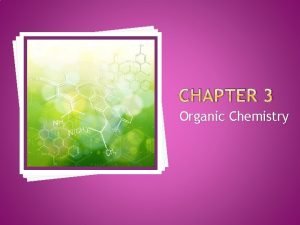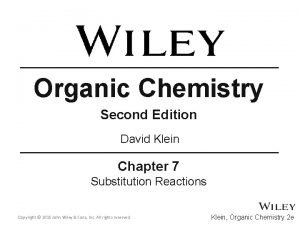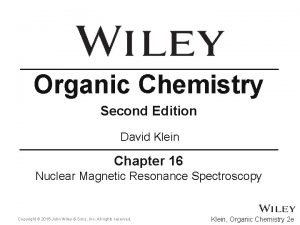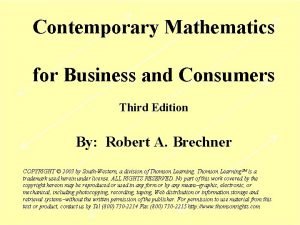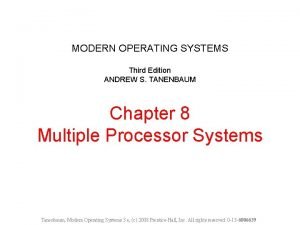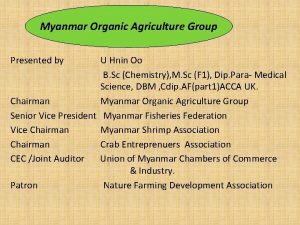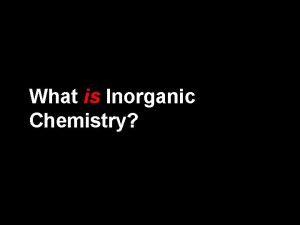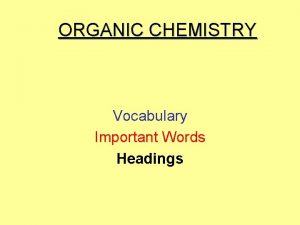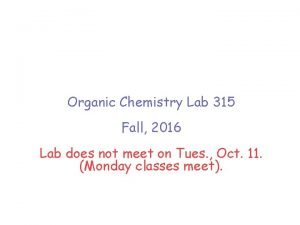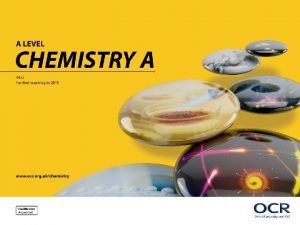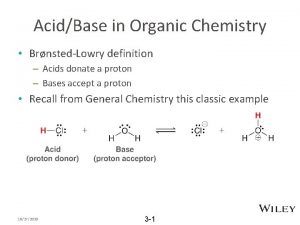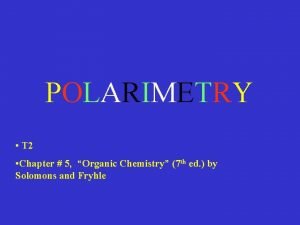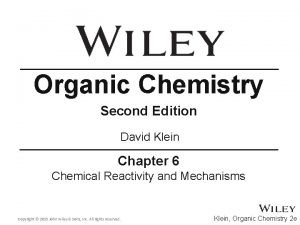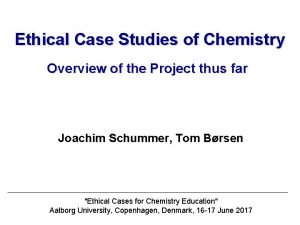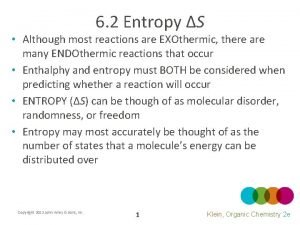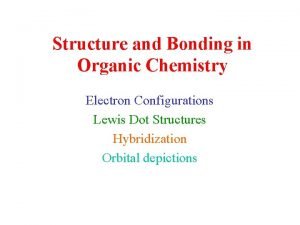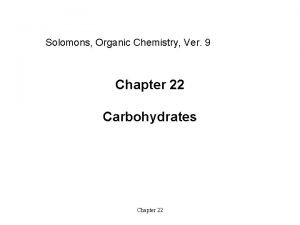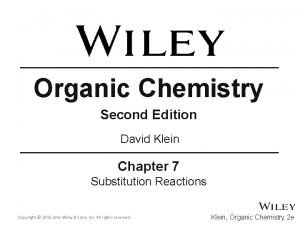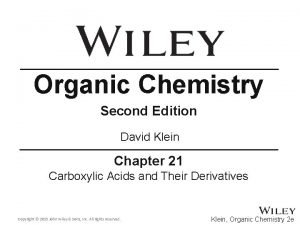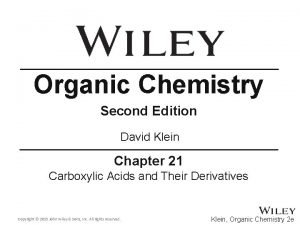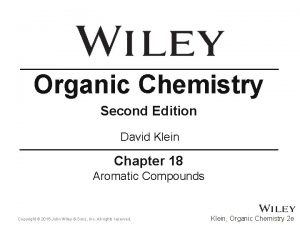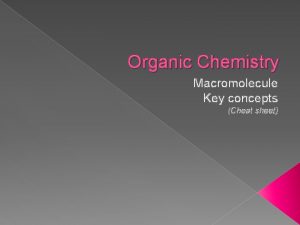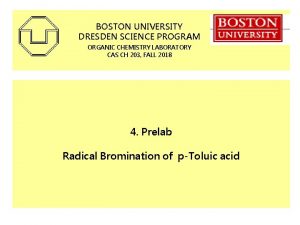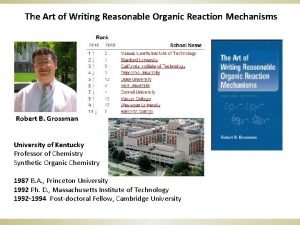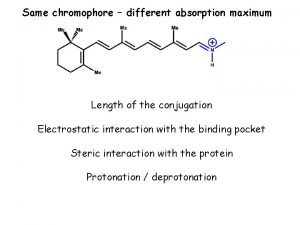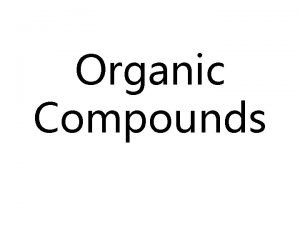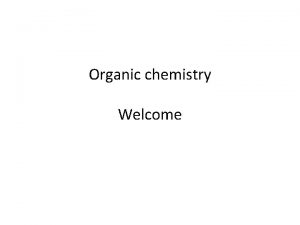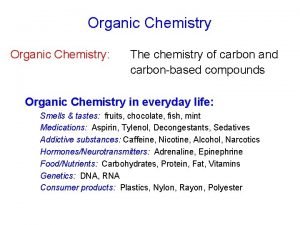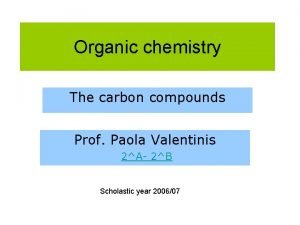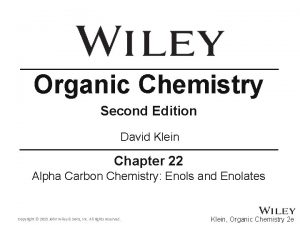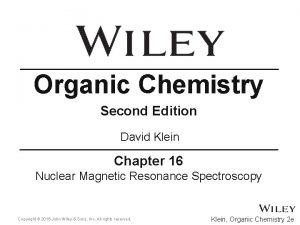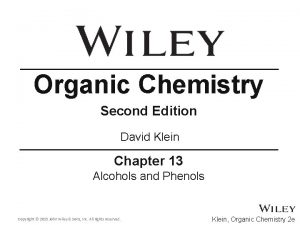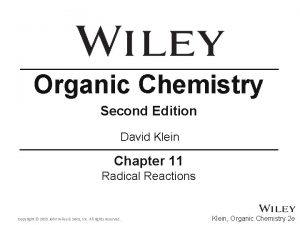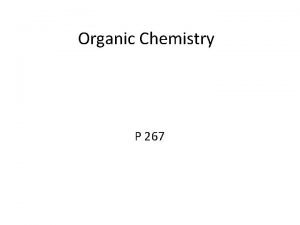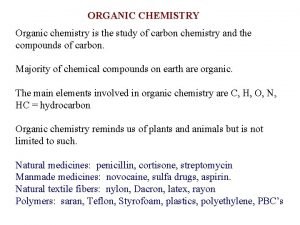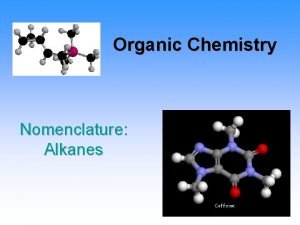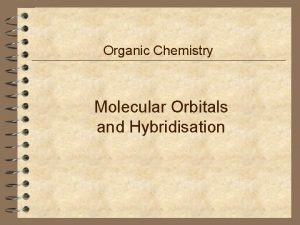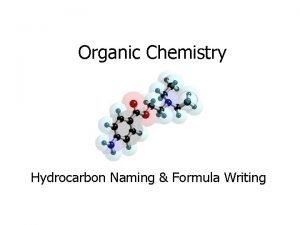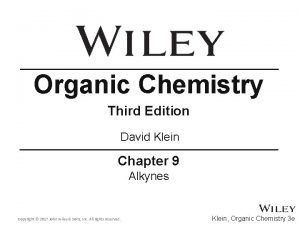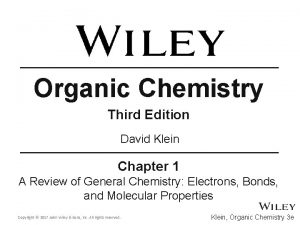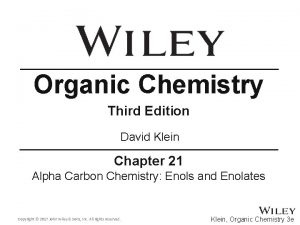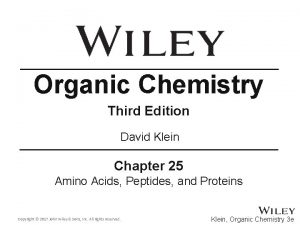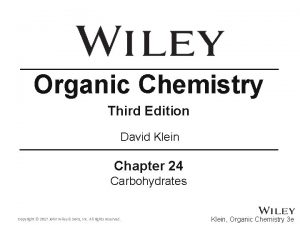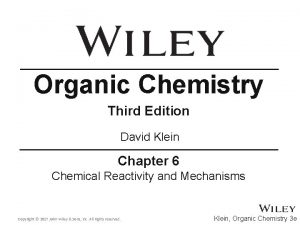Organic Chemistry Third Edition David Klein Chapter 16
































![16. 7 Diels-Alder Reactions • Diels-Alder reactions can be very useful [4+2] cycloaddition • 16. 7 Diels-Alder Reactions • Diels-Alder reactions can be very useful [4+2] cycloaddition •](https://slidetodoc.com/presentation_image/472dcca69ace3c3f4ce16028f33b2d7e/image-33.jpg)























![16. 8 MO Descriptions of Cycloadditions • Similar to a Diels-Alder ([4+2] cycloaddition), the 16. 8 MO Descriptions of Cycloadditions • Similar to a Diels-Alder ([4+2] cycloaddition), the](https://slidetodoc.com/presentation_image/472dcca69ace3c3f4ce16028f33b2d7e/image-57.jpg)


![16. 8 MO Descriptions of Cycloadditions • [2+2] cycloadditions are only possible when light 16. 8 MO Descriptions of Cycloadditions • [2+2] cycloadditions are only possible when light](https://slidetodoc.com/presentation_image/472dcca69ace3c3f4ce16028f33b2d7e/image-60.jpg)
![16. 8 MO Descriptions of Cycloadditions • [2+2] cycloadditions are only possible when light 16. 8 MO Descriptions of Cycloadditions • [2+2] cycloadditions are only possible when light](https://slidetodoc.com/presentation_image/472dcca69ace3c3f4ce16028f33b2d7e/image-61.jpg)















![16. 10 Sigmatropic Rearrangements • [1, 5] sigmatropic rearrangement Copyright © 2017 John Wiley 16. 10 Sigmatropic Rearrangements • [1, 5] sigmatropic rearrangement Copyright © 2017 John Wiley](https://slidetodoc.com/presentation_image/472dcca69ace3c3f4ce16028f33b2d7e/image-77.jpg)
![16. 10 Sigmatropic Rearrangements • Cope rearrangement - a [3, 3] sigmatropic reaction in 16. 10 Sigmatropic Rearrangements • Cope rearrangement - a [3, 3] sigmatropic reaction in](https://slidetodoc.com/presentation_image/472dcca69ace3c3f4ce16028f33b2d7e/image-78.jpg)
![16. 10 Sigmatropic Rearrangements • Claisen rearrangement - a [3, 3] sigmatropic reaction and 16. 10 Sigmatropic Rearrangements • Claisen rearrangement - a [3, 3] sigmatropic reaction and](https://slidetodoc.com/presentation_image/472dcca69ace3c3f4ce16028f33b2d7e/image-79.jpg)
![16. 10 Sigmatropic Rearrangements • Claisen rearrangement - a [3, 3] sigmatropic reaction and 16. 10 Sigmatropic Rearrangements • Claisen rearrangement - a [3, 3] sigmatropic reaction and](https://slidetodoc.com/presentation_image/472dcca69ace3c3f4ce16028f33b2d7e/image-80.jpg)













- Slides: 93

Organic Chemistry Third Edition David Klein Chapter 16 Conjugated Pi Systems and Pericyclic Reactions Copyright © 2017 John Wiley & Sons, Inc. All rights reserved. Klein, Organic Chemistry 3 e

16. 1 Classes of Dienes • Three types of dienes: • Cumulated diene – pi bonds are adjacent • Conjugated diene – pi bonds are separated by a single bond • Isolated diene – pi bonds are separated by more than one single bond Copyright © 2017 John Wiley & Sons, Inc. All rights reserved. 16 -2 Klein, Organic Chemistry 3 e

16. 1 Classes of Dienes • Three types of dienes: • Cumulated – pi bonds are perpendicular (no conjugation) • Conjugated – continuous system of overlapping p orbitals • Isolated – pi bonds are separated (no conjugation) Copyright © 2017 John Wiley & Sons, Inc. All rights reserved. 16 -3 Klein, Organic Chemistry 3 e

16. 1 Classes of Dienes • This chapter focuses on conjugated systems, and the special properties and reactivity associated with them. • Heteroatoms may be involved in a conjugated system • Practice with Conceptual Checkpoint 16. 1 Copyright © 2017 John Wiley & Sons, Inc. All rights reserved. 16 -4 Klein, Organic Chemistry 3 e

16. 2 Preparation of Conjugated Dienes • A sterically hindered base can be used to form dienes via elimination reaction • Practice with conceptual checkpoint 16. 2 Copyright © 2017 John Wiley & Sons, Inc. All rights reserved. 16 -5 Klein, Organic Chemistry 3 e

16. 2 Conjugated Dienes – Bond Lengths • Single bonds that are part of a conjugated pi system are shorter than typical single bonds • This is due, at least in part, to overlap of sp 2 orbitals, versus sp 3 Copyright © 2017 John Wiley & Sons, Inc. All rights reserved. 16 -6 Klein, Organic Chemistry 3 e

16. 2 Conjugated Dienes • The more s-character, the shorter the orbitals, and the shorter sigma bonds will be. • Practice with conceptual checkpoint 17. 3 Copyright © 2017 John Wiley & Sons, Inc. All rights reserved. 16 -7 Klein, Organic Chemistry 3 e

16. 2 Conjugated Dienes • Heats of hydrogenation show conjugated dienes are more stable? • 15 k. J/mol of stabilization energy when 2 p bonds are conjugated Copyright © 2017 John Wiley & Sons, Inc. All rights reserved. 16 -8 Klein, Organic Chemistry 3 e

16. 2 Conjugated Dienes • Rank the following compounds in order of increasing stability Copyright © 2017 John Wiley & Sons, Inc. All rights reserved. 16 -9 Klein, Organic Chemistry 3 e

16. 2 Conjugated Dienes • Generally, sigma bonds freely rotate • The two most stable rotational conformations for butadiene are the s-cis and s-trans • P orbitals are conjugated only in these two rotamers Copyright © 2017 John Wiley & Sons, Inc. All rights reserved. 16 -10 Klein, Organic Chemistry 3 e

16. 2 Conjugated Dienes • s-trans lower in energy, it has less steric hindrance Copyright © 2017 John Wiley & Sons, Inc. All rights reserved. 16 -11 Klein, Organic Chemistry 3 e

16. 2 Conjugated Dienes • The highest energy conformer is not conjugated, and is 15 k. J less stable Copyright © 2017 John Wiley & Sons, Inc. All rights reserved. 16 -12 Klein, Organic Chemistry 3 e

16. 3 Molecular Orbital Theory Review of MO theory: • Two atomic orbitals overlap to form two new MO’s • The MO extends over the entire molecule • Overlap of the p orbitals in ethylene result in a bonding MO and an antibonding MO Copyright © 2017 John Wiley & Sons, Inc. All rights reserved. 16 -13 Klein, Organic Chemistry 3 e

16. 3 Molecular Orbital Theory MO’s for butadiene: Copyright © 2017 John Wiley & Sons, Inc. All rights reserved. 16 -14 Klein, Organic Chemistry 3 e

16. 3 Molecular Orbital Theory • The 4 p electrons in butadiene will occupy the lowest energy MOs. Copyright © 2017 John Wiley & Sons, Inc. All rights reserved. 16 -15 Klein, Organic Chemistry 3 e

16. 3 Molecular Orbital Theory • MO theory offers an alternate explanation why the central C-C single bond is shorter and stronger than a typical C-C single bond Copyright © 2017 John Wiley & Sons, Inc. All rights reserved. 16 -16 Klein, Organic Chemistry 3 e

16. 3 Molecular Orbital Theory • 1, 3, 5 -Hexatriene Copyright © 2017 John Wiley & Sons, Inc. All rights reserved. 16 -17 Klein, Organic Chemistry 3 e

16. 3 Molecular Orbital Theory • Reactions that molecules undergo can often be explained by studying their frontier orbitals • Light can be used to excite an electron from the HOMO to the LUMO • Practice with Conceptual Checkpoint 16. 5 Copyright © 2017 John Wiley & Sons, Inc. All rights reserved. 16 -18 Klein, Organic Chemistry 3 e

16. 4 Electrophilic Addition • Recall addition of H-X to a C=C double bond (Markovnikov addition, section 9. 3) • Two products obtained with a conjugated diene: Copyright © 2017 John Wiley & Sons, Inc. All rights reserved. 16 -19 Klein, Organic Chemistry 3 e

16. 4 Electrophilic Addition • Protonation results in the most stable carbocation; in this case, an allylic carbocation. • Primary carbocation will not form Copyright © 2017 John Wiley & Sons, Inc. All rights reserved. 16 -20 Klein, Organic Chemistry 3 e

16. 4 Electrophilic Addition • Nu attack at either of the two carbons results in two products Product of 1, 2 -addition Product of 1, 4 -addition • Practice with Skill. Builder 16. 1 Copyright © 2017 John Wiley & Sons, Inc. All rights reserved. 16 -21 Klein, Organic Chemistry 3 e

16. 4 Electrophilic Addition • The addition of bromine to a conjugated diene also results in two products: both 1, 2 and 1, 4 addition occurs Copyright © 2017 John Wiley & Sons, Inc. All rights reserved. 16 -22 Klein, Organic Chemistry 3 e

16. 5 Thermodynamic vs. Kinetic Control • The ratio of 1, 2 vs. 1, 4 addition is highly dependent on temperature • An energy diagram of the two reaction pathways efficiently explains why this selectivity is observed Copyright © 2017 John Wiley & Sons, Inc. All rights reserved. 16 -23 Klein, Organic Chemistry 3 e

16. 5 Thermodynamic vs. Kinetic Control • The formation of 1, 2 -adduct occurs faster (kinetically favored) • The 1, 4 adduct is more stable (thermodynamically favored) Copyright © 2017 John Wiley & Sons, Inc. All rights reserved. 16 -24 Klein, Organic Chemistry 3 e

16. 5 Thermodynamic vs. Kinetic Control • The 1, 4 adduct is more stable; it is the more substituted alkene • At higher temps, the formation of product(s) is equilibrating; the reaction is under thermodynamic control. The product that is more stable will be the major product Copyright © 2017 John Wiley & Sons, Inc. All rights reserved. 16 -25 Klein, Organic Chemistry 3 e

16. 5 Thermodynamic vs. Kinetic Control • The 1, 2 adduct forms faster presumably due to a proximity effect. • At lower temps, the reaction is under kinetic control; the reaction is irreversible, the product that forms faster is the major product • Practice with Skillbuilder 16. 2 Copyright © 2017 John Wiley & Sons, Inc. All rights reserved. 16 -26 Klein, Organic Chemistry 3 e

16. 5 Natural and Synthetic Rubbers • Many polymerization reactions are a special case of 1, 4 addition Natural rubber Synthetic rubber • Practice with Conceptual Checkpoint 16. 12 Copyright © 2017 John Wiley & Sons, Inc. All rights reserved. 16 -27 Klein, Organic Chemistry 3 e

16. 6 Intro to Pericyclic Reactions • Pericyclic reactions occur without ionic or free radical intermediates • There are three main types of pericyclic reactions 1. Cycloaddition reactions Copyright © 2017 John Wiley & Sons, Inc. All rights reserved. 16 -28 Klein, Organic Chemistry 3 e

16. 6 Intro to Pericyclic Reactions • Pericyclic reactions occur without ionic or free radical intermediates • There are three main types of pericyclic reactions 2. Electrocyclic Reactions Copyright © 2017 John Wiley & Sons, Inc. All rights reserved. 16 -29 Klein, Organic Chemistry 3 e

16. 6 Intro to Pericyclic Reactions • Pericyclic reactions occur without ionic or free radical intermediates • There are three main types of pericyclic reactions 3. Sigmatropic Rearrangement Copyright © 2017 John Wiley & Sons, Inc. All rights reserved. 16 -30 Klein, Organic Chemistry 3 e

16. 6 Intro to Pericyclic Reactions • Pericyclic reactions have 4 characteristic features 1. The reaction mechanism is concerted. It proceeds without any intermediates 2. The mechanism involves a ring of electrons moving around a closed loop 3. The transition state is cyclic 4. The polarity of the solvent generally has no effect on the reaction rate (transition state has little, if any, charge) Copyright © 2017 John Wiley & Sons, Inc. All rights reserved. 16 -31 Klein, Organic Chemistry 3 e

16. 6 Intro to Pericyclic Reactions • Changes in the number of pi and sigma bonds distinguish the pericyclic reactions from one another Copyright © 2017 John Wiley & Sons, Inc. All rights reserved. 16 -32 Klein, Organic Chemistry 3 e
![16 7 DielsAlder Reactions DielsAlder reactions can be very useful 42 cycloaddition 16. 7 Diels-Alder Reactions • Diels-Alder reactions can be very useful [4+2] cycloaddition •](https://slidetodoc.com/presentation_image/472dcca69ace3c3f4ce16028f33b2d7e/image-33.jpg)
16. 7 Diels-Alder Reactions • Diels-Alder reactions can be very useful [4+2] cycloaddition • Like all pericyclic reactions, the mechanism is concerted (the curved arrows can be draw clockwise or counterclockwise) Copyright © 2017 John Wiley & Sons, Inc. All rights reserved. 16 -33 Klein, Organic Chemistry 3 e

16. 7 Diels-Alder Reactions Copyright © 2017 John Wiley & Sons, Inc. All rights reserved. 16 -34 Klein, Organic Chemistry 3 e

16. 7 Diels-Alder Reactions • Most Diels-Alder reactions are thermodynamically favored at low and moderate temperatures; product stability dominates • At temperatures above 200 ˚C, the retro Diels-Alder can predominate; entropy is the dominant factor Copyright © 2017 John Wiley & Sons, Inc. All rights reserved. 16 -35 Klein, Organic Chemistry 3 e

16. 7 Diels-Alder Reactions • The pi bond sigma bond conversion provides a (-)ΔH Copyright © 2017 John Wiley & Sons, Inc. All rights reserved. 16 -36 Klein, Organic Chemistry 3 e

16. 7 Diels-Alder Reactions • ΔS should be (-), two molecules combine to form a single product Copyright © 2017 John Wiley & Sons, Inc. All rights reserved. 16 -37 Klein, Organic Chemistry 3 e

16. 7 Diels-Alder Reactions • For Diels-Alder rxn, the enthalpy term must be larger than the entropy term for the reaction to be favored. • At very high temps, entropy term opposes the formation of product (retro Diels-Alder is favored). • Ideal temp is typically between room temp and 200 ˚C Copyright © 2017 John Wiley & Sons, Inc. All rights reserved. 16 -38 Klein, Organic Chemistry 3 e

16. 7 Diels-Alder Reactions • the reactants are the diene and dienophile • dienophile needs to possess an electron withdrawing group or the reaction will require high temp, which does not favor product formation Copyright © 2017 John Wiley & Sons, Inc. All rights reserved. 16 -39 Klein, Organic Chemistry 3 e

16. 7 Diels-Alder Reactions • When an electron withdrawing group is attached to the dienophile, the reaction is generally spontaneous • the groups highlighted in red are electron withdrawing Copyright © 2017 John Wiley & Sons, Inc. All rights reserved. 16 -40 Klein, Organic Chemistry 3 e

16. 7 Diels-Alder Reactions • Diels-Alder reactions are stereospecific depending on whether a (E) or (Z) dienophile is used • An alkyne can also function as a dienophile: • Practice with Skillbuilder 16. 3 Copyright © 2017 John Wiley & Sons, Inc. All rights reserved. 16 -41 Klein, Organic Chemistry 3 e

16. 7 Diels-Alder Reactions • Recall that many dienes can exist in an s-cis or an s-trans conformation • Diels-Alder reactions can only occur when the diene is in the s-cis conformation Copyright © 2017 John Wiley & Sons, Inc. All rights reserved. 16 -42 Klein, Organic Chemistry 3 e

16. 7 Diels-Alder Reactions • Dienes trapped in an s-trans conformation can not undergo Diels -Alder reaction, because carbons 1 and 4 are too far apart 1 4 • Dienes that are locked into the s-cis conformation undergo Diels. Alder reactions readily Copyright © 2017 John Wiley & Sons, Inc. All rights reserved. 16 -43 Klein, Organic Chemistry 3 e

16. 7 Diels-Alder Reactions • Cyclopentadiene is so reactive towards Diels-Alder reaction that it reacts without itself at room temperature to form a dimer: • Practice with Conceptual Checkpoint 16. 15 -16. 16 Copyright © 2017 John Wiley & Sons, Inc. All rights reserved. 16 -44 Klein, Organic Chemistry 3 e

16. 7 Diels-Alder Reactions • When bicyclic systems form, the terms ENDO and EXO are used to describe functional group positioning Copyright © 2017 John Wiley & Sons, Inc. All rights reserved. 16 -45 Klein, Organic Chemistry 3 e

16. 7 Diels-Alder Reactions • The electron withdrawing groups attached to dieneophiles tend to occupy the endo position. Often the endo product is the only observed product Major product Copyright © 2017 John Wiley & Sons, Inc. All rights reserved. 16 -46 Minor product Klein, Organic Chemistry 3 e

16. 7 Diels-Alder Reactions • The endo transition state benefits from favorable interaction between the withdrawing groups and the developing pi bond • The exo transition state does not have the favorable interaction Copyright © 2017 John Wiley & Sons, Inc. All rights reserved. 16 -47 Klein, Organic Chemistry 3 e

16. 7 Diels-Alder Reactions • The endo transition state is lower in energy, and so the endo product forms faster: • Practice with Conceptual Checkpoint 16. 17 Copyright © 2017 John Wiley & Sons, Inc. All rights reserved. 16 -48 Klein, Organic Chemistry 3 e

16. 7 Diels-Alder Regioselectivity • Only one regiochemical outcome if the diene or dienophile is symmetrical: Copyright © 2017 John Wiley & Sons, Inc. All rights reserved. 16 -49 Klein, Organic Chemistry 3 e

16. 7 Diels-Alder Regioselectivity • If diene and dienophile are both unsymmetrical, then two regioisomeric products are possible: • One of the regioisomers is formed as the major product; the reaction is regioselective Copyright © 2017 John Wiley & Sons, Inc. All rights reserved. 16 -50 Klein, Organic Chemistry 3 e

16. 7 Diels-Alder Regioselectivity • The major product of Diels-Alder can be predicted by considering the charge distribution of the reactants: • Consider the location of the partial charges, and the attractive force(s) that result(s)… Copyright © 2017 John Wiley & Sons, Inc. All rights reserved. 16 -51 Klein, Organic Chemistry 3 e

16. 7 Diels-Alder Regioselectivity • The alignment of the electrostatic forces results in a lower energy transition state; the major product is formed faster • Practice with Conceptual Checkpoint 16. 18 Copyright © 2017 John Wiley & Sons, Inc. All rights reserved. 16 -52 Klein, Organic Chemistry 3 e

16. 8 MO Descriptions of Cycloadditions • Consider the MO’s for the simplest 1, 3 -diene and dienophile Copyright © 2017 John Wiley & Sons, Inc. All rights reserved. 16 -53 Klein, Organic Chemistry 3 e

16. 8 MO Descriptions of Cycloadditions • For Diels-Alder, the HOMO of one compound must interact with the LUMO of the other Copyright © 2017 John Wiley & Sons, Inc. All rights reserved. 16 -54 Klein, Organic Chemistry 3 e

16. 8 MO Descriptions of Cycloadditions • With an electron withdrawing group, the dieneophile’s LUMO will accept electrons from the diene’s HOMO Copyright © 2017 John Wiley & Sons, Inc. All rights reserved. 16 -55 Klein, Organic Chemistry 3 e

16. 8 MO Descriptions of Cycloadditions • The phases of the reacting MO’s must be symmetrical • In other words, if there is conservation of orbital symmetry, then the reaction is symmetry allowed • Note the carbons that change their hybridization from sp 2 to sp 3 Copyright © 2017 John Wiley & Sons, Inc. All rights reserved. 16 -56 Klein, Organic Chemistry 3 e
![16 8 MO Descriptions of Cycloadditions Similar to a DielsAlder 42 cycloaddition the 16. 8 MO Descriptions of Cycloadditions • Similar to a Diels-Alder ([4+2] cycloaddition), the](https://slidetodoc.com/presentation_image/472dcca69ace3c3f4ce16028f33b2d7e/image-57.jpg)
16. 8 MO Descriptions of Cycloadditions • Similar to a Diels-Alder ([4+2] cycloaddition), the reaction below is a [2+2] cycloaddition • The reacting MO’s (HOMO and LUMO) can be analyzed to determine if the reaction is symmetry-allowed. Copyright © 2017 John Wiley & Sons, Inc. All rights reserved. 16 -57 Klein, Organic Chemistry 3 e

16. 8 MO Descriptions of Cycloadditions • The LUMO of one reactant must have the same symmetry as the HOMO of the other reactant, in order for reaction to occur: Copyright © 2017 John Wiley & Sons, Inc. All rights reserved. 16 -58 Klein, Organic Chemistry 3 e

16. 8 MO Descriptions of Cycloadditions • The phases of the HOMO and LUMO can not line up; the reaction is symmetry-forbidden: Copyright © 2017 John Wiley & Sons, Inc. All rights reserved. 16 -59 Klein, Organic Chemistry 3 e
![16 8 MO Descriptions of Cycloadditions 22 cycloadditions are only possible when light 16. 8 MO Descriptions of Cycloadditions • [2+2] cycloadditions are only possible when light](https://slidetodoc.com/presentation_image/472dcca69ace3c3f4ce16028f33b2d7e/image-60.jpg)
16. 8 MO Descriptions of Cycloadditions • [2+2] cycloadditions are only possible when light is used to excite an electron Copyright © 2017 John Wiley & Sons, Inc. All rights reserved. 16 -60 Klein, Organic Chemistry 3 e
![16 8 MO Descriptions of Cycloadditions 22 cycloadditions are only possible when light 16. 8 MO Descriptions of Cycloadditions • [2+2] cycloadditions are only possible when light](https://slidetodoc.com/presentation_image/472dcca69ace3c3f4ce16028f33b2d7e/image-61.jpg)
16. 8 MO Descriptions of Cycloadditions • [2+2] cycloadditions are only possible when light is used to excite an electron. In this case the reaction is symmetry-allowed: • Practice with Conceptual Checkpoint 16. 19 Copyright © 2017 John Wiley & Sons, Inc. All rights reserved. 16 -61 Klein, Organic Chemistry 3 e

16. 9 Intro to Electrocyclic Reactions • Electrocyclic reaction – pericyclic process where a conjugated polyene undergoes cyclization: • Overall, a p-bond is converted to a s-bond Copyright © 2017 John Wiley & Sons, Inc. All rights reserved. 16 -62 Klein, Organic Chemistry 3 e

16. 9 Electrocyclic Reactions • When substituents are present on the terminal carbons, stereoisomers are possible: • Note that the use of light versus heat yields different stereoisomers Copyright © 2017 John Wiley & Sons, Inc. All rights reserved. 16 -63 Klein, Organic Chemistry 3 e

16. 9 Electrocyclic Reactions • Note that both the stereochemistry of the reactants AND the conditions (heat vs. light) affect the stereochemistry of the product • Conservation of orbital symmetry explains this observation Copyright © 2017 John Wiley & Sons, Inc. All rights reserved. 16 -64 Klein, Organic Chemistry 3 e

16. 9 Electrocyclic Reactions • Consider the stereochemical outcome resulting from thermal cyclization of a p system with three conjugated p bonds: • Note: room temperature is often sufficient to facilitate thermal cyclization Copyright © 2017 John Wiley & Sons, Inc. All rights reserved. 16 -65 Klein, Organic Chemistry 3 e

16. 9 Electrocyclic Reactions • The symmetry of the HOMO determines the outcome • The outermost lobes of the HOMO rotate so like phases overlap Copyright © 2017 John Wiley & Sons, Inc. All rights reserved. 16 -66 Klein, Organic Chemistry 3 e

16. 9 Electrocyclic Reactions • The outermost lobes of the HOMO rotate so like phases overlap • Disrotatory rotation (one rotates clockwise and the other counterclockwise) gives the cis product Copyright © 2017 John Wiley & Sons, Inc. All rights reserved. 16 -67 Klein, Organic Chemistry 3 e

16. 9 Electrocyclic Reactions • The symmetry of the HOMO determines the outcome • The outermost lobes of the HOMO rotate as they become sp 3 hybridized so that like phases overlap Copyright © 2017 John Wiley & Sons, Inc. All rights reserved. 16 -68 Klein, Organic Chemistry 3 e

16. 9 Electrocyclic Reactions • The outermost lobes of the HOMO rotate so like phases overlap • conrotatory rotation - both rotate clockwise the same direction, to yield (in this example) the trans product Copyright © 2017 John Wiley & Sons, Inc. All rights reserved. 16 -69 Klein, Organic Chemistry 3 e

16. 9 Electrocyclic Reactions • Under thermal conditions: • Conjugated systems with 6 p electrons = disrotatory • Conjugated systems with 4 p electrons = conrotatory • Practice with Conceptual Checkpoint 16. 20 Copyright © 2017 John Wiley & Sons, Inc. All rights reserved. 16 -70 Klein, Organic Chemistry 3 e

16. 9 Electrocyclic Reactions • Under photochemical conditions, light energy excites an electron from the HOMO to the LUMO • What was the LUMO becomes the new HOMO Copyright © 2017 John Wiley & Sons, Inc. All rights reserved. 16 -71 Klein, Organic Chemistry 3 e

16. 9 Electrocyclic Reactions • In this case, cyclization must occur in a conrotatory fashion Disrotatory cyclization conrotatory cyclization Copyright © 2017 John Wiley & Sons, Inc. All rights reserved. 16 -72 Klein, Organic Chemistry 3 e

16. 9 Electrocyclic Reactions • The same “switching” of stereochemistry is also observed in conjugated systems with 4 p electrons: conrotatory cyclization Disrotatory cyclization Copyright © 2017 John Wiley & Sons, Inc. All rights reserved. 16 -73 Klein, Organic Chemistry 3 e

16. 9 Electrocyclic Reactions • The Woodward-Hoffmann rules summarize the trends for electrocyclic reactions: • Practice with Skill. Builder 16. 4 Copyright © 2017 John Wiley & Sons, Inc. All rights reserved. 16 -74 Klein, Organic Chemistry 3 e

16. 10 Sigmatropic Rearrangements • Sigmatropic Rearrangements – a pericyclic reaction in which one sigma bond is replaced with another • the location of the p bonds changes as well Copyright © 2017 John Wiley & Sons, Inc. All rights reserved. 16 -75 Klein, Organic Chemistry 3 e

16. 10 Sigmatropic Rearrangements • notation for sigmatropic rearrangements: • Count the number of atoms on each side of the sigma bonds that are breaking and forming • This is a [3, 3] sigmatropic rearrangement Copyright © 2017 John Wiley & Sons, Inc. All rights reserved. 16 -76 Klein, Organic Chemistry 3 e
![16 10 Sigmatropic Rearrangements 1 5 sigmatropic rearrangement Copyright 2017 John Wiley 16. 10 Sigmatropic Rearrangements • [1, 5] sigmatropic rearrangement Copyright © 2017 John Wiley](https://slidetodoc.com/presentation_image/472dcca69ace3c3f4ce16028f33b2d7e/image-77.jpg)
16. 10 Sigmatropic Rearrangements • [1, 5] sigmatropic rearrangement Copyright © 2017 John Wiley & Sons, Inc. All rights reserved. 16 -77 Klein, Organic Chemistry 3 e
![16 10 Sigmatropic Rearrangements Cope rearrangement a 3 3 sigmatropic reaction in 16. 10 Sigmatropic Rearrangements • Cope rearrangement - a [3, 3] sigmatropic reaction in](https://slidetodoc.com/presentation_image/472dcca69ace3c3f4ce16028f33b2d7e/image-78.jpg)
16. 10 Sigmatropic Rearrangements • Cope rearrangement - a [3, 3] sigmatropic reaction in which all 6 atoms in the cyclic transition state are carbon atoms • Equilibrium favors the more substitute alkene(s) Copyright © 2017 John Wiley & Sons, Inc. All rights reserved. 16 -78 Klein, Organic Chemistry 3 e
![16 10 Sigmatropic Rearrangements Claisen rearrangement a 3 3 sigmatropic reaction and 16. 10 Sigmatropic Rearrangements • Claisen rearrangement - a [3, 3] sigmatropic reaction and](https://slidetodoc.com/presentation_image/472dcca69ace3c3f4ce16028f33b2d7e/image-79.jpg)
16. 10 Sigmatropic Rearrangements • Claisen rearrangement - a [3, 3] sigmatropic reaction and is the oxygen analogue of a Cope rearrangement: • Occurs with allylic vinylic ethers • Equilibrium favors the formation of the C=O bond (more stable than a C=C bond) Copyright © 2017 John Wiley & Sons, Inc. All rights reserved. 16 -79 Klein, Organic Chemistry 3 e
![16 10 Sigmatropic Rearrangements Claisen rearrangement a 3 3 sigmatropic reaction and 16. 10 Sigmatropic Rearrangements • Claisen rearrangement - a [3, 3] sigmatropic reaction and](https://slidetodoc.com/presentation_image/472dcca69ace3c3f4ce16028f33b2d7e/image-80.jpg)
16. 10 Sigmatropic Rearrangements • Claisen rearrangement - a [3, 3] sigmatropic reaction and is the oxygen analogue of a Cope rearrangement: • Also observed with allylic aryl ethers • Practice with Conceptual Checkpoint 16. 23 – 16. 26 Copyright © 2017 John Wiley & Sons, Inc. All rights reserved. 16 -80 Klein, Organic Chemistry 3 e

16. 10 Sigmatropic Rearrangements • Two pericyclic reactions occur in the biosynthesis of Vitamin D Copyright © 2017 John Wiley & Sons, Inc. All rights reserved. 16 -81 Klein, Organic Chemistry 3 e

16. 11 UV-Vis Spectroscopy • Compounds with conjugated p systems absorb UV or visible light • Light energy is converted into potential energy Copyright © 2017 John Wiley & Sons, Inc. All rights reserved. 16 -82 Klein, Organic Chemistry 3 e

16. 11 UV-Vis Spectroscopy • In general, the necessary energy to excite an electron from π π* (HOMO to LUMO) falls within the UV or visible region of the spectrum Copyright © 2017 John Wiley & Sons, Inc. All rights reserved. 16 -83 Klein, Organic Chemistry 3 e

16. 11 UV-Vis Spectroscopy • UV-Vis spectroscopy gives structural information about molecules – The amount of light absorbed by a sample is function of wavelength, called absorbance (A): UV-Vis spectrum of butadiene Copyright © 2017 John Wiley & Sons, Inc. All rights reserved. 16 -84 Klein, Organic Chemistry 3 e

16. 11 UV-Vis Spectroscopy • More conjugation gives a smaller π π* energy gap • The smaller the energy gap, the greater the lmax 217 Copyright © 2017 John Wiley & Sons, Inc. All rights reserved. 258 16 -85 290 Klein, Organic Chemistry 3 e

16. 11 UV-Vis: Woodward-Fieser Rules • The group of atoms responsible for absorbing UV-Vis light is known as the chromophore • Woodward and Fieser developed rules to predict λmax for chromophore starting with butadiene as the base Copyright © 2017 John Wiley & Sons, Inc. All rights reserved. 16 -86 Klein, Organic Chemistry 3 e

16. 11 UV-Vis Spectroscopy • The Woodward-Fieser rules are a guide to estimate λmax Copyright © 2017 John Wiley & Sons, Inc. All rights reserved. 16 -87 Klein, Organic Chemistry 3 e

16. 11 UV-Vis Spectroscopy • Practice with Skill. Builder 16. 5 Copyright © 2017 John Wiley & Sons, Inc. All rights reserved. 16 -88 Klein, Organic Chemistry 3 e

16. 12 Color • Highly conjugated compounds absorb light in the visible region of the spectrum (400 -700 nm) Responsible for the red color of tomatoes Responsible for the orange color of carrots Copyright © 2017 John Wiley & Sons, Inc. All rights reserved. 16 -89 Klein, Organic Chemistry 3 e

16. 12 Color • The color observed by your eyes will be the opposite of what is required to cause the π π* excitation. • Practice with Conceptual Checkpoint 16. 29 Copyright © 2017 John Wiley & Sons, Inc. All rights reserved. 16 -90 Klein, Organic Chemistry 3 e

16. 13 Chemistry of Vision • Rods and Cones are photosensitive cells in your eyes: – Rods: do not detect color (they dominate in dim lighting). – Cones: are responsible for detection of color. Light-sensitive compounds in rods Copyright © 2017 John Wiley & Sons, Inc. All rights reserved. 16 -91 Klein, Organic Chemistry 3 e

16. 13 Chemistry of Vision • Sources of 11 -cis-retinal include Vitamin A and β-carotene Copyright © 2017 John Wiley & Sons, Inc. All rights reserved. 16 -92 Klein, Organic Chemistry 3 e

16. 13 Chemistry of Vision • When rhodopsin is excited photochemically, a change in shape occurs that causes a release of Ca 2+ ions • The Ca 2+ ions block channels through which billions of Na+ ions generally travel each second • The decrease of Na+ ion flow culminates in a nerve impulse to the brain • Our eyes are extremely sensitive • Just a few photons can cause a nerve impulse Copyright © 2017 John Wiley & Sons, Inc. All rights reserved. 16 -93 Klein, Organic Chemistry 3 e
 Carboxylic acid h3o+ reaction
Carboxylic acid h3o+ reaction Organic chemistry third edition david klein
Organic chemistry third edition david klein Transition state energy diagram
Transition state energy diagram David klein organic chemistry
David klein organic chemistry Organic chemistry
Organic chemistry Klein organic chemistry 2nd edition
Klein organic chemistry 2nd edition Organic chemistry 2nd edition klein
Organic chemistry 2nd edition klein Organic chemistry (3rd) edition chapter 1 problem 16s
Organic chemistry (3rd) edition chapter 1 problem 16s Halohydrin
Halohydrin Ib chemistry organic chemistry
Ib chemistry organic chemistry Inorganic chemistry vs organic chemistry
Inorganic chemistry vs organic chemistry Organic vs inorganic compounds
Organic vs inorganic compounds Chapter 22 review organic chemistry section 1 answers
Chapter 22 review organic chemistry section 1 answers Organic chemistry chapter 9
Organic chemistry chapter 9 Chapter 7 organic chemistry
Chapter 7 organic chemistry Entane
Entane Analytical chemistry chapters
Analytical chemistry chapters Gingival third vs cervical third
Gingival third vs cervical third Gj mount classification
Gj mount classification David klein
David klein David klein
David klein Principle of management oxford fajar pdf
Principle of management oxford fajar pdf Business mathematics third edition
Business mathematics third edition Modern operating systems tanenbaum
Modern operating systems tanenbaum Fundamentals of corporate finance canadian edition
Fundamentals of corporate finance canadian edition Sujata madan
Sujata madan Lifespan development third edition
Lifespan development third edition Lifespan development third edition
Lifespan development third edition Essential cell biology
Essential cell biology Dr ruth yates
Dr ruth yates Numbering carbon chains
Numbering carbon chains Canola oil
Canola oil Ester organic chemistry
Ester organic chemistry But-1-ene
But-1-ene Ee organic chemistry
Ee organic chemistry Ario organic chemistry
Ario organic chemistry Ario practice problems
Ario practice problems Functional groups priority
Functional groups priority Organic chemistry lab report format
Organic chemistry lab report format Www.masterorganicchemistry.com
Www.masterorganicchemistry.com Organic chemistry grade 10
Organic chemistry grade 10 Cyclo organic chemistry
Cyclo organic chemistry Organic chemistry wade
Organic chemistry wade Crash course chemistry naming compounds
Crash course chemistry naming compounds Why is ceramic wool heated in cracking
Why is ceramic wool heated in cracking What is chemistry
What is chemistry Organic chemistry myanmar
Organic chemistry myanmar Propagation organic chemistry
Propagation organic chemistry High resolution
High resolution Hono organic chemistry
Hono organic chemistry Vicinal dihalide
Vicinal dihalide Topic 11 organic chemistry
Topic 11 organic chemistry Organic chemistry reaction pathways
Organic chemistry reaction pathways Organic chemistry nomenclature
Organic chemistry nomenclature What is organic chemistry like
What is organic chemistry like Neon organic or inorganic
Neon organic or inorganic Organic chemistry vocabulary
Organic chemistry vocabulary Separation scheme of caffeine from vivarin tablets
Separation scheme of caffeine from vivarin tablets A level chemistry ocr organic synthesis
A level chemistry ocr organic synthesis Rancidity meaning
Rancidity meaning Ario+
Ario+ How to calculate percentage yield in organic chemistry
How to calculate percentage yield in organic chemistry Polarimetry organic chemistry
Polarimetry organic chemistry Radicals
Radicals Hammond's postulate organic chemistry
Hammond's postulate organic chemistry Chemistry ethics case studies
Chemistry ethics case studies Hammond's postulate organic chemistry
Hammond's postulate organic chemistry Lewis dot structure ch4
Lewis dot structure ch4 Oxidation of carbohydrates
Oxidation of carbohydrates Resonance in benzyl carbocation
Resonance in benzyl carbocation Organic chemistry
Organic chemistry Organic chemistry
Organic chemistry Organic chemistry
Organic chemistry Macromolecule cheat sheet
Macromolecule cheat sheet Mindup mind map
Mindup mind map Ethos
Ethos Ir spectroscopy
Ir spectroscopy The art of writing reasonable organic reaction mechanisms
The art of writing reasonable organic reaction mechanisms Conjugation organic chemistry
Conjugation organic chemistry Organic chemistry
Organic chemistry Condensed structure of cyclohexane
Condensed structure of cyclohexane Which allotrope of carbon feels greasy and crumbles easily?
Which allotrope of carbon feels greasy and crumbles easily? 3 carbon chain name
3 carbon chain name Organic chemistry
Organic chemistry Organic chemistry
Organic chemistry Organic chemistry
Organic chemistry Organic chemistry
Organic chemistry Nbs reaction
Nbs reaction Organic composition definition
Organic composition definition Butan 2 on
Butan 2 on Where is lysine found
Where is lysine found Organic chemistry class 11 notes
Organic chemistry class 11 notes Hybridisation
Hybridisation Condensed structural formula
Condensed structural formula















